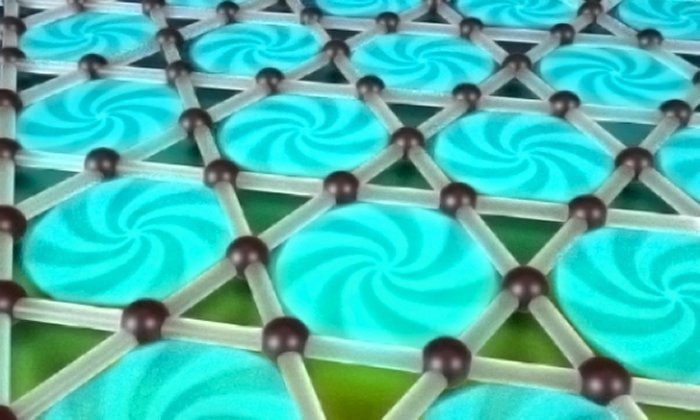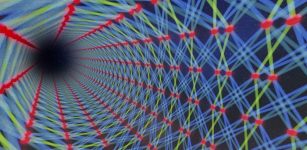A Candidate Superconductor Useful In Future Quantum Computation – Developed
Eddie Gonzales Jr. – MessageToEagle.com – Since receiving a $25 million grant in 2019 to become the first National Science Foundation (NSF) Quantum Foundry, UC Santa Barbara researchers affiliated with the foundry have been working to develop materials that can enable quantum information-based technologies for such applications as quantum computing, communications, sensing, and simulation.
They may have done it.

In a new paper published in the journal Nature Materials, foundry co-director and UCSB materials professor Stephen Wilson, and multiple co-authors, including key collaborators at Princeton University, study a new material developed in the Quantum Foundry as a candidate superconductor — a material in which electrical resistance disappears and magnetic fields are expelled— that could be useful in future quantum computation.
A previous paper published by Wilson’s group in the journal Physical Review Letters and featured in Physics magazine described a new material, cesium vanadium antimonide (CsV3Sb5), that exhibits a surprising mixture of characteristics involving a self-organized patterning of charge intertwined with a superconducting state. The discovery was made by Elings Postdoctoral Fellow Brenden R. Ortiz. As it turns out, Wilson said, those characteristics are shared by a number of related materials, including RbV3Sb5 and KV3Sb5, the latter (a mixture of potassium, vanadium and antimony) being the subject of this most recent paper, titled “Discovery of unconventional chiral charge order in kagome superconductor KV3Sb5.”
Materials in this group of compounds, Wilson noted, “are predicted to host interesting charge density wave physics [that is, their electrons self-organize into a non-uniform pattern across the metal sites in the compound]. The peculiar nature of this self-organized patterning of electrons is the focus of the current work.”
This predicted charge density wave state and other exotic physics stem from the network of vanadium (V) ions inside these materials, which form a corner-sharing network of triangles known as a kagome lattice. KV3Sb5 was discovered to be a rare metal built from kagome lattice planes, one that also superconducts. Some of the material’s other characteristics led researchers to speculate that charges in it may form tiny loops of current that create local magnetic fields.
Materials scientists and physicists have long predicted that a material could be made that would exhibit a type of charge density wave order that breaks what is called time reversal symmetry. “That means that it has a magnetic moment, or a field, associated with it,” Wilson said. “You can imagine that there are certain patterns on the kagome lattice where the charge is moving around in a little loop. That loop is like a current loop, and it will give you a magnetic field. Such a state would be a new electronic state of matter and would have important consequences for the underlying unconventional superconductivity.”
The role of Wilson’s group was to make the material and characterize its bulk properties. The Princeton team then used high-resolution scanning tunnelling microscopy (STM) to identify what they believe are the signatures of such a state, which, Wilson said “are also hypothesized to exist in other anomalous superconductors, such as those that superconduct at high temperature, though it has not been definitively shown.”
STM works by scanning a very sharp metal wire tip over a surface. By bringing the tip extremely close to the surface and applying an electrical voltage to the tip or to the sample, the surface can be imaged down to the scale of resolving individual atoms and where the electrons group. In the paper the researchers describe seeing and analyzing a pattern of order in the electronic charge, which changes as a magnetic field is applied. This coupling to an external magnetic field suggests a charge density wave state that creates its own magnetic field.
This is exactly the kind of work for which the Quantum Foundry was established. “The foundry’s contribution is important,” Wilson said. “It has played a leading role in developing these materials, and foundry researchers discovered superconductivity in them and then found signatures indicating that they may possess a charge density wave. Now, the materials are being studied worldwide, because they have various aspects that are of interest to many different communities.
“They are of interest, for instance, to people in quantum information as potential topological superconductors,” he continued. “They are of interest to people who study new physics in topological metals, because they potentially host interesting correlation effects, defined as the electrons’ interacting with one another, and that is potentially what provides the genesis of this charge density wave state. And they’re of interest to people who are pursuing high-temperature superconductivity because they have elements that seem to link them to some of the features seen in those materials, even though KV3Sb5 superconducts at a fairly low temperature.”
If KV3Sb5 turns out to be what it is suspected of being, it could be used to make a topological qubit useful in quantum information applications. For instance, Wilson said, “In making a topological computer, one wants to make qubits whose performance is enhanced by the symmetries in the material, meaning that they don’t tend to decohere [decoherence of fleeting entangled quantum states being a major obstacle in quantum computing] and therefore have a diminished need for conventional error correction.
“There are only certain kinds of states you can find that can serve as a topological qubit, and a topological superconductor is expected to host one,” he added. “Such materials are rare. This system may be of interest for that, but it’s far from confirmed, and it’s hard to confirm whether it is or not. There is a lot left to be done in understanding this new class of superconductors.”
Written by Eddie Gonzales Jr. MessageToEagle.com Staff










